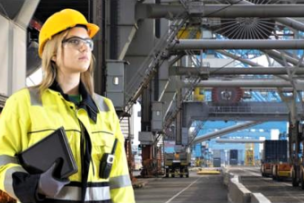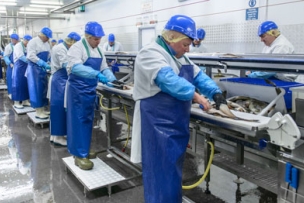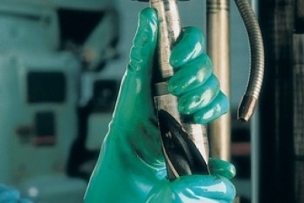Safety Guide: The 4 Hazardous Chemical Exposure PPE Levels
This hazardous chemical exposure PPE cheat sheet provides a quick reference guide about the four EPA levels for personal protective equipment that will help manufacturing shop floors comply with OSHA workplace safety regulations.
This guide to the four PPE levels for hazardous chemical exposure provides a quick reference primer for safety managers and shop floor chiefs.
The government prescribes four levels‚ A through D, of personal protective equipment when it comes to safeguarding workers from exposure to potentially toxic chemicals. Our guide gathers information from the Environmental Protection Agency and from the Occupational Safety and Health Administration so you can have the key details at your fingertips.
We’ve inverted the order, starting with PPE Level D, because for many day-to-day needs on the shop floor, this level’s minimal protective requirements will be adequate. But remember: Each manufacturing facility must establish the appropriate PPE needs for its workers based on the specific realities and risks present on its shop floor.
In all likelihood, you might need equipment across levels depending on the specific work—and where and how that work will be performed.
The mandate is clear. “OSHA regulations require employers to protect their employees from workplace hazards such as machines, work procedures and hazardous substances that can cause injury,” notes OSHA’s Office of Training and Education in its guidance about assessing the need for PPE.
The guidance points out that it’s up to each employer to determine if hazards are present that necessitate PPE use and then to comply by providing the appropriate PPE as required by OSHA 29 CFR 1910.132.
PPE Level D: Safety Managers Need to Sweat the Small Stuff on PPE
OSHA looks to employers to protect their workers even from what it describes as “nuisance contamination.” At this level, contact with skin, eyes or lungs clearly wouldn’t be lethal, but it’s important to avoid any unexpected exposure even when there is “no known hazard,” OSHA says.
At Level D, each worker will need:
- Coveralls
- Boots or shoes with chemical-resistant steel toes and shanks
There is no respirator requirement, and the rest of the items are optional and should be provided based on your safety assessment. This includes gloves, disposable chemical-resistant outer boots, safety glasses or splash goggles, hard hats, escape masks and face shields.
When Level D applies: There are no known hazards in the workplace. Chemical splashes or immersions while performing the work are unlikely, as is inhalation of any chemicals or particulate.
Would you like some help finding the right protective clothing? Use our self-directed, interactive product selector to find everything you need.
PPE Level C: Safety Plans Must Ensure Respiratory Protection
A critical piece of solving the PPE puzzle for your business involves screening for and knowing specific concentrations of any airborne hazardous substances. Once airborne substances and their concentrations are known, you must provide workers with respiratory protection.
Your assessment and testing of airborne substances will help you refine your selection of respiratory protective gear.
At Level C, each worker will need:
- Full-face or half-mask air-purifying respirators (approved by the National Institute for Occupational Safety and Health)
- Hooded chemical-resistant clothing
- Inner and outer chemical-resistant gloves
When it comes to the hooded clothing required for Level C, OSHA leaves that up to the individual safety team to decide whether overalls, two-piece chemical splash suits or disposable chemical-resistant overalls will do the job.
As at Level D, other items are optional: coveralls, chemical-resistant steel-toe and steel-shank outer boots, disposable chemical-resistant outer boot covers, hard hats, escape masks and face shields.
When Level C applies: The known contaminants in the workspace cannot be absorbed through the skin. The types and concentration of contaminants can be removed through use of an air-purifying respirator.
Want more info on PPE? Check out our video on matching PPE with specific jobs.
PPE Level B: Heavier Focus Must Go to Respiratory and Skin Protection
The move up to B demands the highest level of respiratory protection, according to OSHA. It’s needed when the chance of inhalation of an airborne substance definitely exists and is generally greater than the risk of skin exposure.
At Level B, each worker will need:
- Either a positive-pressure, full-facepiece self-contained breathing apparatus or a positive-pressure, supplied-air respirator with escape SCBA (approved by NIOSH)
- Hooded chemical-resistant clothing
- Inner and outer chemical-resistant gloves
- Chemical-resistant steel-toe and steel-shank outer boots
Again, some additional PPE remains optional, including coveralls, disposable chemical-resistant outer boot covers, hard hats and face shields.
When Level B applies: Concentrations of substances with the potential to harm lungs but perhaps not skin have been identified. The atmosphere contains less than 19.5 percent oxygen. Unknown gaseous vapors are present but suggest a low likelihood of harm to skin.
PPE Level A: Skin, Lungs and Eyes Demand Complete Protection
At the top tier, the risk to health is so potentially dangerous that workers need PPE that will protect them from exposure of any kind. Chemicals must not be able to reach eyes, skin or lungs.
At Level A, each worker will need:
- Either a positive-pressure, full-facepiece self-contained breathing apparatus or a positive-pressure, supplied-air respirator with escape SCBA (approved by NIOSH)
- Totally encapsulating chemical-protective suit
- Inner and outer chemical-resistant gloves
- Chemical-resistant steel-toe and steel-shank boots
- Disposable protective suit, gloves and boots (could be worn over the totally encapsulating suit)
Little is left to chance at this level with only a couple of optional items: coveralls, long underwear and hard hats.
When Level A applies: There are known high concentrations of hazardous chemicals. The work could result in splashes or immersion. The work will be done in a confined or closed space.
How to Select the Right PPE and Assess Product Performance Criteria
“The more that is known about the hazards at the site, the easier the job of PPE selection becomes,” OSHA points out in 1910.120 App B. “As more information about the hazards and conditions at the site becomes available, the site supervisor can make decisions to upgrade or downgrade the level of PPE protection to match the tasks at hand.”
A chief challenge for safety managers? Aligning their PPE needs with performance specs for products they’re considering for their workers. To that end, the American National Standards Institute issued the voluntary ANSI/ISEA 125-2014, which details the ways safety product makers should share conformity assessments so that buyers can verify PPE level performance.
“By formalizing conformity assessment in a consistent way, this standard gives users an important … tool to make confident decisions when purchasing PPE,” said Eric Beck, former chairman of the ISEA board, at the time of the standard’s publication.
Typically, products—whether optional or required—will be labeled as to the specific EPA level they meet based on ANSI/ISEA conformity assessments.
Remember too that on a metalworking shop floor or in a large manufacturing facility, additional PPE may be needed to protect workers from, say, flying metal shards, vibrating equipment and deafness-inducing noise. These additional items—for instance, hardened eyewear, cut-resistant or anti-vibration gloves, and earmuffs—must be provided as appropriate to comply with OSHA PPE rules.
Stay OSHA-Compliant by Conducting PPE Checks Regularly
Periodic PPE checks are also critical to staying OSHA-compliant and ensuring use of gear by employees—trust but verify. Newer PPE tends to improve fit and also comfort, and both are a focus of safety product makers when they upgrade gear.
“New innovations and manufacturing abilities are allowing safety managers to get PPE that fits their people rather than fitting their people to the PPE,” points out an article in ISHN magazine. “So even if you have an unusual safety need and can’t seem to find something that fits, think outside the box.”
Looking to amplify your workplace safety? Check out our interview with PPE specialist, Bill Simkins, for more PPE tips.
Share the levels of PPE that are needed at your site and how your business helps ensure broad adoption.





Talk to Us!
Leave a reply
Your email address will not be published. Required fields are marked *